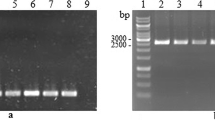Abstract
The phenomena following the transformation of the fungusCochliobolus lunatus by plasmid-encoded HmB resistance were investigated. All of the 16 tested transformants had markedly altered morphology. Unlike the untransformed fungus, the transformants produced both conidia and arthrospores, did not excrete slime, lost their purple color, and had an altered progesterone-bioconverting pathway.
Similar content being viewed by others
Literature Cited
Brock DT (1970) Mutants and their isolation. In: McElroy D, Swanson CP (eds) Biology of microorganisms. Englewood Cliffs: Prentice-Hall, Inc., pp 303–309
Dermastia M, Rozman D, Komel R (1991) Heterologous transformation ofCochliobolus lunatus. FEMS Microbiol Lett 77:145–150
Farman ML, Oliver RP (1988) The transformation of protoplasts ofLeptosphaeria maculans to hygromycin B resistance. Curr Genet 13:327–330
Hafez-Zedan H, Plourde R (1973) Steroid 1-dehydrogenation and side-chain degradation enzymes in the life cycle ofFusarium solani. Biochim Biophys Acta 326:103–115
Höerhold C, Undisz K, Groh H, Sahm R, Scade W, Komel R (1986) Bioconversion of steroids byCochliobolus lunatus. Z Allg Mikrobiol 26:335–339
Kendrick WB (1981) The systematics of Hyphomycetes. In: Cole GT, Kendrick WB (eds) Biology of Conidial Fungi, vol 1. New York, London, Toronto, Sydney, San Francisco: Academic Press, pp 21–42
Kistler HC, Benny UK (1988) Genetic transformation of the fungal plant pathogen,Fusarium oxysporum. Curr Genet 13:145–149
Leung H, Lehtinen U, Karjalainen R, Skinner D, Tooley P, Leong S, Ellingboe A (1990) Transformation of the rice blast fungusMagnaporthe grisea to hygromycin B resistance. Curr Genet 17:409–411
Luttrell ES (1977) Deuteromycetes and their relationships. In: Kendrick WB (ed) The whole fungus. Ottawa: National Museums of Canada, pp 241–264
Mishra E (1985) Gene transfer in fungi. Advan Genet 23:73–178
Muller E (1979) Factors inducing asexual and sexual sporulation in fungi. In: Kendrick WB (ed) The whole fungus. Ottawa: National Museums of Canada, pp 265–282
Osiewacz HD, Weber A (1989) DNA mediated transformation of the filamentous fungusCurvularia lunata using a dominant selectable marker. Appl Microbiol Biotechnol 30:375–380
Plemenitaš A, Žakelj-Mavrič M, Komel R (1988) Hydroxysteroid dehydrogenase ofCochliobolus lunatus. J Steroid Biochem 29:371–372
Plourde R, Hafez-Zedan H (1973) Distribution of steroid 1-dehydrogenation and side-chain degradation enzymes in the spores ofFusarium solani: causes of metabolic lag and carbohydrate independence. Appl Microbiol 25:650–658
Punt PJ, Oliver RP, Dingemanse MA, Pouwels PH, Van den Hondel CAMJJ (1987) Transformation ofAspergillus based on the hygromycin B resistance marker fromE. coli. Gene 56:117–124
Turgeon BG, Garber RC, Yoder OC (1987) Development of fungal transformation system based on selection of sequences with promoter activity. Mol Cell Biol 7:3297–3305
Author information
Authors and Affiliations
Rights and permissions
About this article
Cite this article
Dermastia, M., Rozman, D. & Komel, R. Morphological changes and induced sporulation in HmBR transformants ofCochliobolus lunatus . Current Microbiology 23, 303–306 (1991). https://doi.org/10.1007/BF02104130
Issue Date:
DOI: https://doi.org/10.1007/BF02104130




